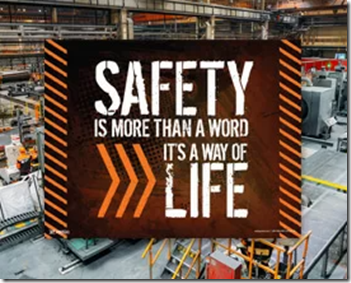Originally posted on August 15, 2022 @ 12:09 PM
 We recently witnessed extremism in safety when the AIHS Visions conference espoused an extremist understanding of persons: ‘humans as hazards’.
We recently witnessed extremism in safety when the AIHS Visions conference espoused an extremist understanding of persons: ‘humans as hazards’.
We also saw recently Safety espousing not a change in safety fundamentalism, but simply making fundamentalism more ‘fun’.
The more Safety pursues the absolute of zero the more its trajectory must become extremist. Such is the dysfunction of perfectionism.
So, in order to help the safety extremists get to their goal quickly, I offer the following methodical advice. Just follow the following Commandments:
- Make sure you are obsessed with safety (https://safetyrisk.net/safety-as-a-mental-health-disorder-obsession/). Proposing that obsession is as a good thing, only makes sense to a safety extremist. Similarly, when I hear safety people talk about how safety is their ‘life’. Such language and obsession indicate a warped view of living and being. The last thing that should drive human living and being is safety.
- Make humans a hazard. If this is what one espouses in safety then humans must be eliminated, the pinnacle of the Hierarchy of Controls (https://safetyrisk.net/the-enemy-of-safety-humans/ ).Ierarchy of Controls.
- Feed insularity and mono-disciplinarity. Keep to knowledge within the mono-discipline of safety. Feed yourself on engineering and behaviourism (https://safetyrisk.net/more-safety-code-to-disguise-behaviourism/).
- Think cultically (https://safetyrisk.net/the-cult-ure-of-zero/). This is helped by running safety workshops as a Hillsong festival. At such conferences it also helps to have banners about of ‘safety saves’ and ‘just believe’ (https://safetyrisk.net/zero-vision-as-propaganda/).
- Worship Zero. There are plenty of resources for you to use here, especially the Spirit of Zero video (https://safetyrisk.net/the-spirit-of-zero/). Use this apocalyptic video often and ensure that the sound is turned up.
- Use religious language to describe safety. Talking about faith and belief in zero, ‘just believe’, ‘safety saves’ and ‘heroes’. These will all help to maintain the metaphysics of zero and safety so that people will think that safety is about having ones head in the clouds.
- Demonise fallibility (https://www.humandymensions.com/product/fallibility-risk-living-uncertainty/). Despite all the evidence to the contrary, make sure you espouse perfect goals, perfect humans and perfect organisations as your identity. Also, when anyone is injured ensure they are blamed for their ‘choice’ and preach ‘all accidents are preventable’ to them.
- Develop rituals and mantras (https://safetyrisk.net/culture-silences-in-safety-ritual/) that convince people that mantras and rituals in themselves ‘saves lives’. This includes ensuring that the completion of paperwork is equated to safety effectiveness (https://safetyrisk.net/paperwork-and-usability-in-tackling-risk/).
I was tempted to run the list to ten, thus mirroring the 10 commandments but thought it more interesting if readers responded with their own suggestions on extremism based on what they have experienced in the safety industry? Just add your thoughts in the comments to be in the draw for a book prize.



Mardi Meadors says
I’m the HR Director in my company and I’m in the process of improving the safety culture. I’m located in California so I’m governed by several regulatory agencies that require me to provide a safe and healthy work environment. I have a duty of care to my employees to make sure they are safe at work. Part of this is providing training, inspecting for hazards, posting warning and other safety signs.
Unfortunately every regulatory agency has specific signage they require me to posted in the work place. Since we have so many agencies, we have signage everywhere and my workforce has become desensitized to the signage.
I don’t have the option of reducing the amount of signage.
I need an approach and procedure to add to our safety culture that will counteract the affective of what I’m calling “Signage Blindness”, I’m looking for some guidance on this issue. I’ve read several articles and blogs but haven’t gotten any real world ways of dealing with this issue.
Any help you can provide is much appreciated
Rob Long says
If it was me, I would ensure that the location of the signs were all congregated together so that they formed a collage of irrelevance. then get on with the real job of culture and let the collage of signs speak for themselves. I would also make sure that the signs were placed where they would have the least relevance.
Interestingly, most in HR don’t what culture is either. https://safetyrisk.net/category/safety-culture-silences/
grumpy says
One business I worked moved the signs around every month believing that because the sign was new in that area people would read it. Lots of make-work for the safety officer and less time actually looking out for people.
Rob Long says
Andrew, Grumpy and Ray. Email me your snail mail address and I’ll post you a copy of ‘It Works!’
Robertlong2@mac.com
Admin says
Let’s not forget being omnipotent and omniscient – an expert on law, engineering, science, statistics, psychology, medicine, teaching, culture, neuroscience, gender equality, sexual harassment, bullying, depression, global warming and global pandemics
Rob Long says
Yes, the messiah complex is indeed a norm in safety.
Andrew Floyd says
Stay Safe. Stop in bed.
Rob Long says
Stasis, the gift of zero.
grumpy says
10: Ostentatiously Display Your Wares: Make sure the ‘Days LTI Free’ sign is the first thing everyone sees when they enter the workplace. Cover every vertical surface in signs prohibiting this and allowing that. Produce voluminous and colourful charts and posters and powerpoint presentations. Make sure ‘SAFETY’ is the first thing discussed at every meeting, toolbox talk, lunchtime get together etc.
Rob Long says
Yes Grumpy, parading propaganda is an essential ingredient for the safety extremist. Especially when it delivers no outcome. You are in the hat.
Ray says
9. Reward concealment. Good safety statistics and zero incident reports prove that lives have been saved. What is a Safety Officer for if not to ensure that injuries only occurred on the weekend, that near-misses don’t spoil the stats and everyone gets a zero-reported-LTIs-jacket-and-pizza-lunch every two years?
Rob Long says
Exactly Ray, you’re in the hat.